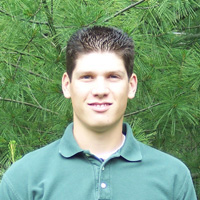 Detrital zircon U-Pb geochronology of Paleozoic prebatholithic rocks in the northeastern Peninsular Ranges of Southern and Baja CaliforniaAdam Cosentino Wednesday, April 25th, 2008 |
||
|
||
| ABSTRACT In the northern Peninsular Ranges of southern and Baja California carbonate – quartzite dominated prebatholithic assemblages display lithologic similarities to in-situ cratonic North American miogeoclinal sequences. Correlation of the Peninsular Ranges rocks to the miogeocline and offshore equivalents however has proven difficult due to pervasive metamorphism and structural disruption associated with Cretaceous batholith emplacement. This study utilizes detrital zircon laser ablation ICPMS U-Pb ages to constrain the provenance and age of the Peninsular Ranges assemblages and make regional stratigraphic correlations in insitu North American rocks. This study is focused on two main stratigraphic packages that represent the thickest and most complete prebatholithic assemblages within this ~350 km-long carbonate – quartzite belt: the Desert Divide Group (DDG) in the north and the Playa San Felipe Group (PSFG) in the south. The DDG at the northern end of the belt is divided into the structurally lower Bull Canyon Formation, comprised of schist, carbonate, and quartzite, and the structurally higher Ken Quartzite, an ~ 700 m thick package of relatively pure quartzite. Upper amphibolite metamorphism has obliterated fossils and sedimentary structures and the relationship between the Bull Canyon Fm and Ken Quartzite has remained uncertain. Detrital zircon U-Pb ages from closely spaced samples within an ~250 m thick section across the Bull Canyon-Ken Quartzite contact record a shift in provenance that matches closely a major Middle Ordovician regional detrital zircon provenance shift associated with the onset of “Peace River Arch” detritus. This shift is documented widely throughout the Cordilleran miogeocline (associated with the Eureka Quartzite) and the timing of the shift is so far best documented from the Vinini Formation where it occurs in the mid to late Middle Ordovician. Detrital zircon U-Pb age spectra from PSFG Unit G quartzite (~430 m thick) yield a post shift, Peace River Arch signature which verifies previous detrital zircon studies on this unit. The close match of Unit G and the Ken Quartzite zircon spectra suggests these are correlative units. It also raises the possibility that the detrital zircon shift from the Bull Canyon to the Ken Quartzite in the DGG may be present in the PSFG. Results from PSFG Unit A quartzite yield a maximum depositional age of Late Devonian based on 3 concordant grains at ~376 Ma. This result suggests that there are much younger Paleozoic stratigraphic elements in the PSFG than has been previously recognized as well as unrecognized structural complications in the area. The Unit A rocks may have correlatives in late Paleozoic sequences documented from the Sierra Las Pintas area ~85 km to the north. Detrital zircon ages were also determined from an olistolith quartzite block deposited into early Mesozoic prebatholithic flysch near Rancho San Marcos in northern Baja California. The quartzite here is associated with carbonates that have yielded late Early Ordovician conodonts; this sample yields a “pre-shift” detrital zircon spectra consistent with the fossil age call. |

